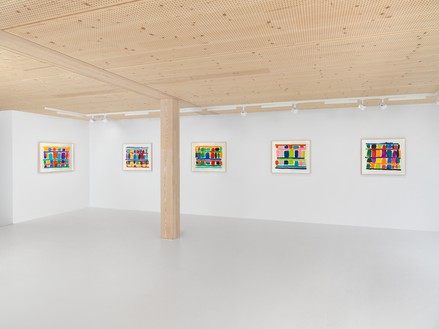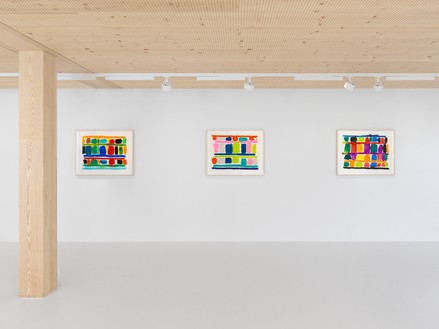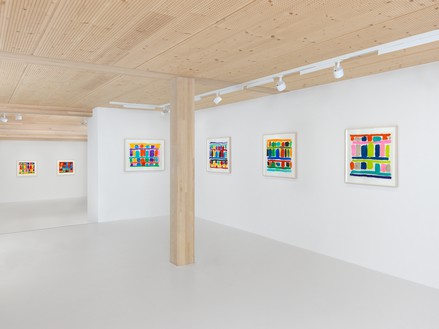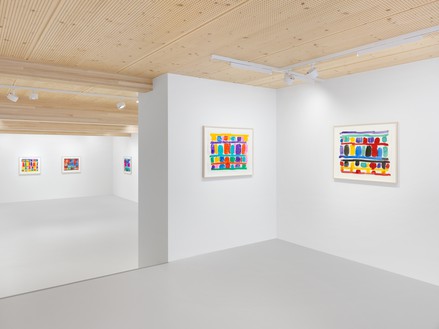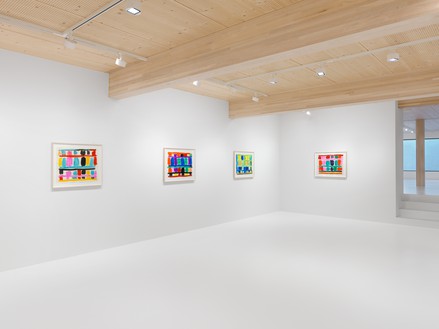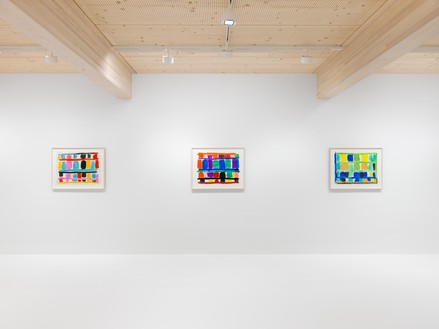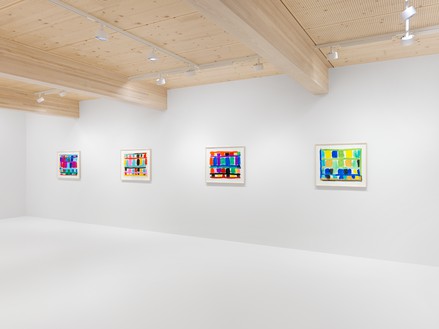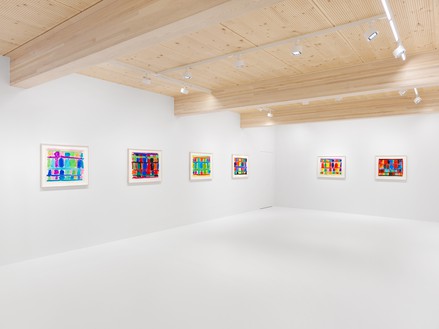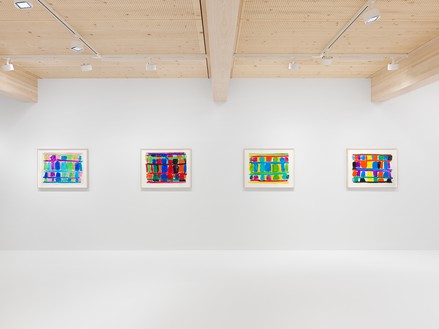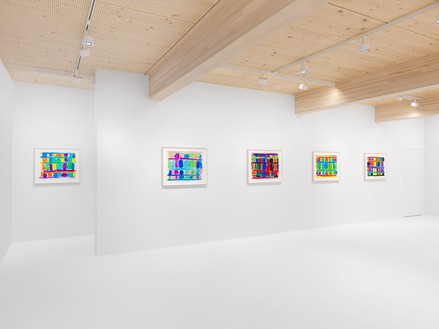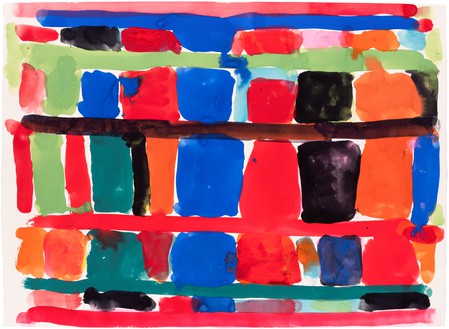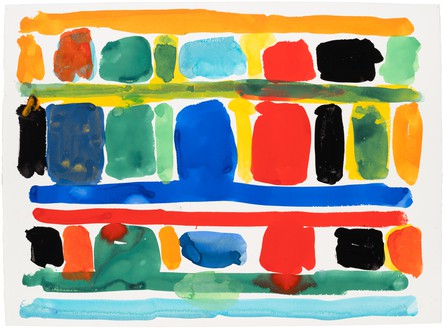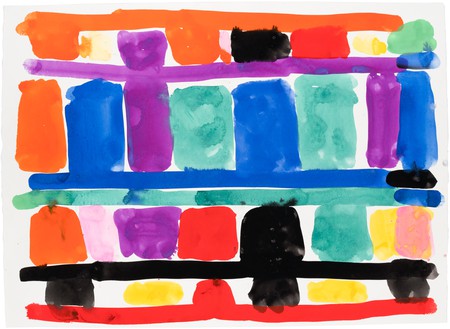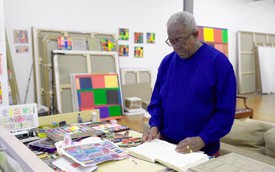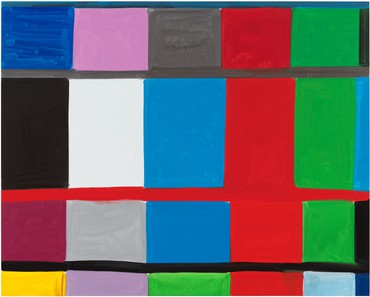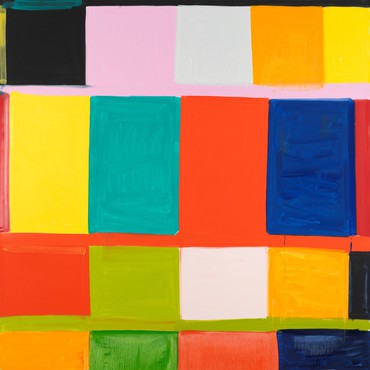About
Gagosian is pleased to celebrate the opening of the holiday season in Gstaad with Stanley Whitney: Paintings on Paper, an exhibition of gouaches made by the artist between 2015 and 2021. This is the third exhibition at the gallery in Gstaad, which opened in 2022.
Whitney’s paintings imbue loose “stacked” compositions with dynamic and unpredictable rhythms of color and space. Inspired by sources as diverse as experimental jazz and American quilt making, he marshals energetically brushed blocks and bars of pigment distinguished by transparency and tension wherever they intersect. Having worked in an abstract mode since the 1970s, he consolidated his current approach in the early 1990s during time spent in Italy. There, captivated by the effect of light on the façades of ancient Roman buildings such as the Colosseum and Palazzo Farnese, he achieved a new understanding of the relationship between color and geometry.
In the gouaches on view in Gstaad, which were made over a seven-year period, Whitney translates the square format of his large-scale canvas paintings to smaller works on paper. These compositions reveal the consistency of structure that undergirds his ostensibly spontaneous project. Far from being mere studies, they are robust independent undertakings in which the artist discovers new possibilities. Like other greats of abstract painting such as Ad Reinhardt and Al Taylor, Whitney takes the simplicity and flexibility of his medium and support as starting points from which to further extend his visual and atmospheric range.
Gagosian freut sich, die Festtage mit einer Ausstellung von Stanley Whitney in Gstaad einzuläuten: Paintings on Paper, an der Gouache-Werke aus den Jahren 2015 bis 2021 zu sehen sind. Dies ist die dritte Ausstellung von 2022 in Gstaad.
In Whitneys locker «geschichteten» Kompositionen fügen sich dynamische Farb- und Raummuster zu immer wieder neuen Rhythmen zusammen. Mit energischen Pinselstrichen gemalte farbige Rechtecke und längliche Formen sind so angeordnet, dass an den Schnittstellen unterschiedliche Transparenz und Spannung entstehen. Inspirieren lässt er sich dabei aus unterschiedlichsten Quellen – von experimentellem Jazz bis amerikanischen Quilts. Er malt schon seit den 1970er-Jahren abstrakt und fand in den frühen 1990-er Jahren während eines Italienaufenthalts zu seiner jetzigen Bildsprache. In Rom faszinierte ihn die Wirkung des Lichts an der Fassade des Kolosseums oder des Palazzo Farnese, was ihm zu einem neuen Verständnis des Zusammenspiels von Farbe und Geometrie verhalf.
In den in Gstaad ausgestellten Gouache-Arbeiten, die über einen Zeitraum von sieben Jahren entstanden sind, hat Whitney die grossformatigen quadratischen Ölbilder auf kleinere Papierformate übertragen. In diesen Kompositionen wird die Kontinuität der Struktur deutlich, die diesem offensichtlich spontanen Malprojekt zugrunde liegt. Es handelt sich dabei keineswegs um Studien, sondern um solide, eigenständige Gemälde, mit denen der Künstler neue Ausdrucksformen erkundet. Wie andere namhafte Vertreter der Abstraktion wie Ad Reinhardt und Al Taylor nutzt Whitney die Vielseitigkeit und Unkompliziertheit dieses Mediums und Malgrunds als Ausgangspunkt, um die visuellen und atmosphärischen Gestaltungsmöglichkeiten weiter auszuschöpfen.
So spielt er mit der Oberflächenstruktur und dem Grundton des Papiers und lässt ein Wechselspiel zwischen Papiergrund und Form zu, das in seinen Ölbildern fehlt: Dort ist die Farbe das einzige Mittel zur Koloration und deckt den gesamten Malgrund. An gewissen Stellen fliessen die übereinander geschichteten «Farbpakete» ineinander oder in die horizontalen Stabformen über, an anderen sind sie klar konturiert. In allen Bildern wird jedoch das unbemalte Papier Teil der Komposition. Diese Entwicklung macht die Grundstruktur besonders deutlich und zeigt auf, wo sich diese wieder auflöst und zu etwas Neuem wird.
Gouache-Farben sind deckende Wasserfarben, die aus Grundpigmenten und pflanzlichen Bindemitteln sowie aus Weiss-Zusätzen wie Ton oder Kreide oder Zusatzpigmenten bestehen, die ihnen ihre besondere Deckkraft verleihen. Whitney schöpft die hohe Farbsättigung dieses Mediums voll aus, doch arbeitet er auch mit Wasser, um einen aquarellartigen Farbauftrag mit durchscheinender Leuchtkraft zu erzielen. Dies verleiht seinen Bildern eine ureigene gesprenkelte und leuchtende Oberflächengestaltung, die – wie bei seinen Ölgemälden – durch Formgebung und Zeitlosigkeit an die Inspiration aus Rom anknüpft.
Stanley Whitney: Dance with Me Henri, eine Ausstellung, die die Buntglasfenster hervorhebt, die Whitney im Auftrag des Ruth R. Marder Center für Matisse Studies im Baltimore Museum of Art geschaffen hat, ist bis zum 23. April 2023 zu sehen.
Gagosian a le plaisir de commencer les fêtes de fin d’année à Gstaad avec Stanley Whitney : Paintings on Paper, une exposition de gouaches réalisées par l’artiste entre 2015 et 2021. Il s’agit de la troisième exposition organisée à la galerie de Gstaad depuis son inauguration en 2022.
Whitney insuffle un rythme de couleur et d’espace dynamique et imprévisible à ses compositions « empilées » et bancales. Tirant son inspiration de sources aussi diverses que le jazz expérimental et la confection de quilts américains, il assemble avec énergie des blocs et des barres de pigments qui se distinguent par une transparence et une tension à leurs intersections. Ayant travaillé en mode abstrait depuis les années 1970, Whitney a consolidé cette approche au début des années 1990 pendant le temps qu’il a passé en Italie. C’est là que, fasciné par les effets de lumière sur les façades des monuments antiques romains comme le Colisée ou le Palais Farnèse, il a acquis une nouvelle compréhension de la relation entre la couleur et la géométrie.
Dans les gouaches présentées à Gstaad, qu’il a réalisées sur une période de sept ans, Whitney transpose le format carré de ces immenses toiles en de plus petits travaux sur papier. Ces compositions révèlent la cohérence de la structure qui sous-tend son projet spontané en apparence. Mais bien plus que d’être de simples études, elles représentent une démarche rigoureuse indépendante dans laquelle l’artiste découvre de nouvelles possibilités. A l’instar d’autres grands de la peinture abstraite tels qu’Ad Reinhardt et Al Taylor, Whitney utilise la simplicité et la souplesse de sa technique et de son support comme points de départ pour élargir sa palette visuelle et atmosphérique.
En permettant à la surface et à la teinte du papier de faire entrer de la texture et des espaces blancs dans ses compositions, Whitney met en scène l’interaction entre la forme et le fond absente de ses toiles, dans laquelle la peinture colore complètement ses œuvres et recouvre entièrement leurs supports. A certains moments, les « paquets » de couleur empilés coulent les uns dans les autres ou dans les barres qui les séparent horizontalement, tout en restant distincts à d’autres moments. Cependant, dans l’ensemble, la surface du papier qui n’a pas été touchée entre en jeu pour devenir un élément de la composition. Ce glissement permet à la trame d’émerger en une clarté particulière ; il fait aussi apparaître le point où cette structure se désintègre pour se transformer en quelque chose de nouveau.
La gouache, peinture à l’eau mate composée de pigments broyés et de liants végétaux, possède une opacité remarquable due à l’addition de liants blancs comme l’argile ou la craie ou à une teneur élevée en pigments. Tout en usant abondamment de la saturation de la couleur propre à cette technique, Whitney dilue aussi sa peinture pour obtenir une lumière translucide lors de son application, que l’on associe plus souvent à l’aquarelle. Les travaux qui en résultent ont une surface tachetée spécifique et une nuance rougeâtre, comme leurs pendants que sont les huiles sur toile ; ils rappellent l’inspiration romaine de Whitney à travers l’interaction vivante entre design et extemporanéité.
Stanley Whitney: Dance with Me Henri, une exposition sure le thème des vitraux commissionés par le Ruth R. Marder Center for Matisse Studies au Baltimore Museum of Art, est à voir jusqu’au 23 avril 2023.
#StanleyWhitney

Stanley Whitney: Vibrations of the Day
Stanley Whitney invited professor and musician-biographer John Szwed to his studio on Long Island, New York, as he prepared for an upcoming survey at the Buffalo AKG Art Museum to discuss the resonances between painting and jazz.
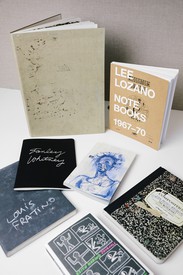
Book Corner
Private Pages Made Public
Megan N. Liberty explores artists’ engagement with notebooks and diaries, thinking through the various meanings that arise when these private ledgers become public.
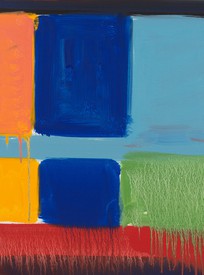
The Space Is in the Color: Stanley Whitney
Stanley Whitney reflects on the evolution of his work with Louise Neri, from his formative early days in New York to the pivotal period he spent living and working in Rome, arriving at the highly distinctive paintings for which he is now known. They explore the diverse and surprising influences of art and music on Whitney’s oeuvre, as well as his process and practice.
Stanley Whitney: Rhythm and Vision
While preparing his first exhibition with Gagosian, in Rome, Stanley Whitney speaks with Louise Neri in his New York studio about how he arrived at his unique and intuitive approach to color and space in painting, employing a dynamic fusion of preordained structure and improvisation.
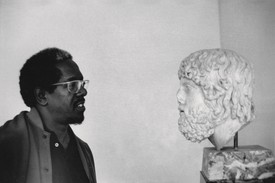
Stanley Whitney: The Ruins
For American painter Stanley Whitney, Italy remains a central and enduring source of inspiration. Matthew Jeffrey Abrams, the author of a new monograph on the artist, reflects on the profound and far-reaching influence of Italian art and architecture on Whitney’s art.

